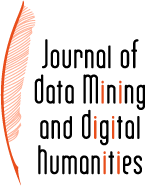 |
Pit Schneider - Combining Morphological and Histogram based Text Line Segmentation in the OCR Context
jdmdh:7277 - Journal of Data Mining & Digital Humanities, 4 novembre 2021, 2021 - https://doi.org/10.46298/jdmdh.7277 Text line segmentation is one of the pre-stages of modern optical character recognition systems. The algorithmic approach proposed by this paper has been designed for this exact purpose. Its main characteristic is the combination of two different techniques, morphological image operations and horizontal histogram projections. The method was developed to be applied on a historic data collection that commonly features quality issues, such as degraded paper, blurred text, or presence of noise. For that reason, the segmenter in question could be of particular interest for cultural institutions, that want access to robust line bounding boxes for a given historic document. Because of the promising segmentation results that are joined by low computational cost, the algorithm was incorporated into the OCR pipeline of the National Library of Luxembourg, in the context of the initiative of reprocessing their historic newspaper collection. The general contribution of this paper is to outline the approach and to evaluate the gains in terms of accuracy and speed, comparing it to the segmentation algorithm bundled with the used open source OCR software.
Comment: Journal of Data Mining and Digital Humanities; Small adjustments
